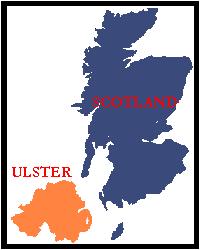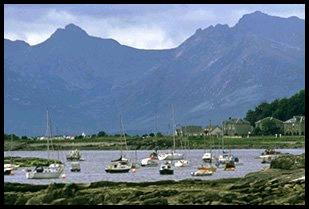|
Ulster-Scots
In our wanderings through Scottish history and the origins of the Scots-Irish we come across references to Presbyterians, Covenanters, Seceders, Burghers and Anti-Burghers; Mountain Men, Old Lights. New Lights, Subscribing and Non-Subscribing churches. Here, for the benefit of the casual enquirer, is an outline of what they were.
Lets us begin with the basics: a covenant is defined as a mutual agreement between two or more people to do or refrain from doing certain things. Importantly, everybody in the covenant is consulted and agrees with the final terms. The Presbyterian belief was that they as individuals had a covenant with God and expected that their religion and agreements concerning it would be the subject of mutual agreement or covenant.
The splinter groups that arose were due to internal disagreements about interpretations of faith or as a response to ongoing external pressures from the government of the day. These groups remained Presbyterian in structure but clung to their particular belief. There were very many changes in the make up of Presbyterianism from its beginnings with John Knox in 1560 into the 20th century.
|
 Ulster & Scotland maps
Ulster and Scotland are quite close, on a clear day the Scottish coast can be seen from the Antrim coast in Ulster!!!
Ulster & Scotland maps
Ulster and Scotland are quite close, on a clear day the Scottish coast can be seen from the Antrim coast in Ulster!!! |
|
Presbyterians?
Presbyterians are adherents of that faith which has at its heart the Disciplines evolved from the teachings of John Calvin (1509- 1564) and John Knox (1515 - 1572). It recognises, as in the New Testament the practices of the Jewish synagogue, the government of each church by its elders. The churches were associated in local presbyteries and represented in provincial synods as well as a National Assembly which was the highest court of appeal. They believed that they had a covenant between themselves and God and were particularly opposed to rule by the bishops who had no place in their scheme of things. Most of their persecution for over a century was associated with this objection.
|
|
Groups and Sects
Covenanters
The Covenanters were those Presbyterians with a concern for a strict faith and its management. They were signatories or adherents to the "National Covenant" of February 1638 which was a response to the King's attempts to change the style of worship of the Church which had not been previously approved (covenanted) by free assemblies and
parliament.
In August, 1643, the Covenanters signed the "Solemn League and Covenant" which was a political treaty. Under this covenant the agreement was to impose Presbyterianism on England and Ireland. In return for this, the Covenanters agreed to support the English Parliamentarians against King Charles I in the Civil War that had broken out.
When Charles' son, King Charles II, returned from exile in 1660 the rule of the bishops (Episcopalianism) was imposed on Scotland. Many people did not conform - especially in Ayrshire, Dumfries and Galloway. These Presbyterians, followers of a strict form of their religion espoused by Richard Cameron, were bloodily persecuted, especially after an armed revolt. Some of the descendants of the Covenanters were called Praying Societies and eventually joined the congregation of Seceders.
Seceders
Presbyterianism became the Established Church in Scotland in 1691 but there were still those who would not accept the settlement because it did not acknowledge the supreme sovreignty of Christ the King nor was it a 'covenanted' settlement. These Seceders or dissenters eventually became the Reformed Presbyterian Church.
In 1712, the Patronage Act reintroduced patronage as the means of appointing ministers thus repealing the earlier agreement of 1689. It also took away from the congregation its cherished right to choose its own minister There was also a trend towards liberalisation as Scotland turned more towards England for its political lead and with it, renewed theological conflict. Opposition to moderate moves were resisted with orthodoxy, subscription of the Confession of Faith and adherence to the National Covenant.
Burghers and Anti- Burghers
In 1733, the patronage issue finally caused dissenting congregations to form the Secession Church. The Associate Presbytery into which the Seceders formed themselves grew rapidly but the reintroduction of patronage and the taking of an oath created another split in the already divided Presbyterian church. On this occasion it was over the requirement to take an oath when elected to serve on town councils in Scottish burghs. Those prepared to tolerate this weakening in principle were called the Burghers and those against the change were the Anti- Burghers. Thus, in 1747 another split took place.
New Light, Old Light
Drained by the debate over patronage and already divided into dissenting groups such as the Covenanters, Cameronians, Burghers and Anti-Burghers, the Presbyterian church then faced a damaging theological challenge. There arose in the universities a movement towards 'moderatism' in which the gospel was reduced to a series of moral rules. Led by the eloquent Francis Hutcheson, son of the Rev. John Hutcheson of Armagh, he and his followers sapped the foundations of the evangelical Presbyterian church. Some ministers became more concerned with culture than salvation and dismissed their heritage. Out of this came yet another split between the the parties, the Old Light who rejected moderatism and the moderate New Light movement who held a softer line that every man must be allowed to hold only what his conscience was persuaded as right and should not be bound by any rule of faith or conduct.
A second secession in 1752 saw another group - the Relief Church, come into being. The two groups of New Lights, who accepted the principle of moderate change eventually joined together in 1820 as the United Secession Church. The two groups of Old Lights finally joined together as the United Original Seceders in 1842.
|
 Ayrshire in Scotland
Ayrshire is in South-West Scotland, and is often a tourist destination by Ferry!
Ayrshire in Scotland
Ayrshire is in South-West Scotland, and is often a tourist destination by Ferry! |
